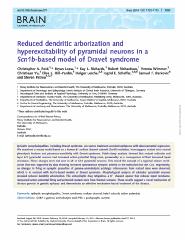Please use this identifier to cite or link to this item:
https://ahro.austin.org.au/austinjspui/handle/1/12181| Title: | Reduced dendritic arborization and hyperexcitability of pyramidal neurons in a Scn1b-based model of Dravet syndrome. | Austin Authors: | Reid, Christopher A;Leaw, Bryan;Richards, Kay L;Richardson, Robert;Wimmer, Verena;Yu, Christiaan;Hill-Yardin, Elisa L;Lerche, Holger;Scheffer, Ingrid E ;Berkovic, Samuel F ;Petrou, Steven | Affiliation: | 1 Florey Institute for Neuroscience and Mental Health, The University of Melbourne, Parkville, 3010, Australia 4 Department of Medicine, Austin Health, The University of Melbourne, Heidelberg West, Melbourne, 3081, Australia 1 Florey Institute for Neuroscience and Mental Health, The University of Melbourne, Parkville, 3010, Australia4 Department of Medicine, Austin Health, The University of Melbourne, Heidelberg West, Melbourne, 3081, Australia5 Department of Paediatrics, The University of Melbourne, Royal Children's Hospital, Melbourne, 3010, Australia Department of Neurology and Epileptology, Hertie Institute of Clinical Brain Research, University of Tübingen, Germany3 Neurological Clinic and Institute of Applied Physiology, University of Ulm, D-89081 Germany. 1 Florey Institute for Neuroscience and Mental Health, The University of Melbourne, Parkville, 3010, Australia6 Centre for Neural Engineering, The University of Melbourne, Parkville, Melbourne, 3010, Australia7 Department of Anatomy and Neuroscience. The University of Melbourne, Parkville, Melbourne, 3010, Australia |
Issue Date: | 17-Apr-2014 | Publication information: | Brain : A Journal of Neurology 2014; 137(Pt 6): 1701-15 | Abstract: | Epileptic encephalopathies, including Dravet syndrome, are severe treatment-resistant epilepsies with developmental regression. We examined a mouse model based on a human β1 sodium channel subunit (Scn1b) mutation. Homozygous mutant mice shared phenotypic features and pharmaco-sensitivity with Dravet syndrome. Patch-clamp analysis showed that mutant subicular and layer 2/3 pyramidal neurons had increased action potential firing rates, presumably as a consequence of their increased input resistance. These changes were not seen in L5 or CA1 pyramidal neurons. This raised the concept of a regional seizure mechanism that was supported by data showing increased spontaneous synaptic activity in the subiculum but not CA1. Importantly, no changes in firing or synaptic properties of gamma-aminobutyric acidergic interneurons from mutant mice were observed, which is in contrast with Scn1a-based models of Dravet syndrome. Morphological analysis of subicular pyramidal neurons revealed reduced dendritic arborization. The antiepileptic drug retigabine, a K+ channel opener that reduces input resistance, dampened action potential firing and protected mutant mice from thermal seizures. These results suggest a novel mechanism of disease genesis in genetic epilepsy and demonstrate an effective mechanism-based treatment of the disease. | Gov't Doc #: | 24747835 | URI: | https://ahro.austin.org.au/austinjspui/handle/1/12181 | DOI: | 10.1093/brain/awu077 | Journal: | Brain | URL: | https://pubmed.ncbi.nlm.nih.gov/24747835 | Type: | Journal Article | Subjects: | Dravet syndrome action potentials beta1 subunit epileptic encephalopathy sodium channel Action Potentials.genetics Animals Dendrites.genetics Disease Models, Animal Epilepsies, Myoclonic.genetics Mice Mice, Inbred C57BL Mutation.genetics Neurons.metabolism Voltage-Gated Sodium Channel beta-1 Subunit.metabolism |
| Appears in Collections: | Journal articles |
Files in This Item:
| File | Description | Size | Format | |
|---|---|---|---|---|
| 24747835.pdf | 1.4 MB | Adobe PDF |  View/Open |
Page view(s)
78
checked on Apr 2, 2025
Download(s)
182
checked on Apr 2, 2025
Google ScholarTM
Check
Items in AHRO are protected by copyright, with all rights reserved, unless otherwise indicated.
